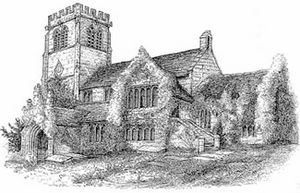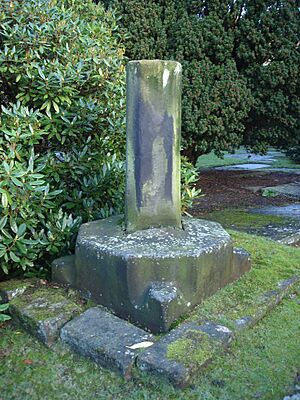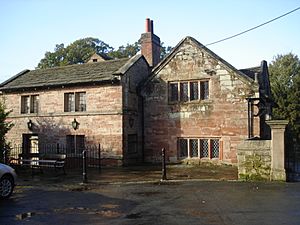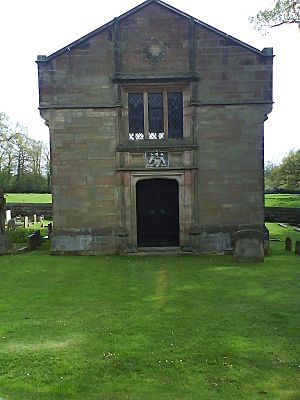St Mary's Church, Nether Alderley facts for kids
Quick facts for kids St Mary's Church, Nether Alderley |
|
|---|---|
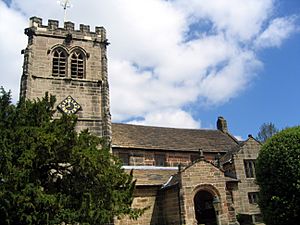
St Mary's Church, Nether Alderley,
from the south in 2008 |
|
| Lua error in Module:Location_map at line 420: attempt to index field 'wikibase' (a nil value). | |
| OS grid reference | SJ 842 761 |
| Location | Nether Alderley, Cheshire |
| Country | England |
| Denomination | Anglican |
| Website | St Mary's Church |
| History | |
| Status | Parish church |
| Dedication | St Mary |
| Architecture | |
| Functional status | Active |
| Heritage designation | Grade I |
| Designated | 14 April 1967 |
| Architect(s) | Cuffley and Starkey Paley and Austin (Restorations) |
| Architectural type | Church |
| Style | Gothic |
| Specifications | |
| Materials | Buff and red sandstone Kerridge stone-slate roof |
| Administration | |
| Parish | Alderley |
| Deanery | Knutsford |
| Archdeaconry | Macclesfield |
| Diocese | Chester |
| Province | York |
St Mary's Church is an old and beautiful Anglican church. It stands at the end of a quiet lane in Nether Alderley, Cheshire, England. The church was first built in the 14th century. It has been changed and updated many times since then. A big restoration happened in the late 1800s.
St Mary's is a very important building. It is listed as a Grade I building on the National Heritage List for England. This means it is a special historic place. The church was built in the Gothic style. It has always been connected to the Stanley family of Alderley.
Some of its cool features include a tall tower and the Stanley family's special seating area. This area, called a pew, has its own outside staircase! Inside, you can see a 14th-century font. There is also a western gallery and monuments to the Lords Stanley of Alderley. Outside, the church grounds have a 17th-century schoolhouse. This building is now used as a community hall. You can also find a medieval church cross and the Stanley Mausoleum, built in 1909. An ancient yew tree, hundreds of years old, grows in the churchyard.
Today, St Mary's is still an active parish church. It is part of the diocese of Chester.
Contents
History of St Mary's Church
The oldest parts of St Mary's Church were built around the year 1300. But there might have been an even older wooden church here before that. The church was first named after Saint Lawrence. Later, its name was changed to Saint Mary.
In the 1400s, a clerestory was added. This is a row of windows high up on the church walls. The tall tower was built in 1530. Around 1600, the special Stanley family pew was added. In 1803, a gallery for musicians was put in at the west end. This gallery held an organ.
In 1856, the chancel, which is the part of the church near the altar, was completely rebuilt. The Stanley family paid for this work. A room for the clergy, called a vestry, was built in 1860. The church had a big restoration between 1877 and 1878. During this time, the floor of the main part of the church was lowered. The old pulpit was replaced. Plaster was removed from the roof and walls. The old box pews were replaced with new oak seats.
The clock in the tower was made in 1743. It was fixed up in 1997. In 2000, the wooden frame for the bells was made stronger with steel. The Stanley pew was also restored.
Church Architecture
Outside the Church
St Mary's Church is built from buff and red sandstone. This stone was dug up nearby at Alderley Edge. The roof is made of Kerridge stone slates. The church has a tower at its west end. It has a main area called a nave with aisles on both sides. There is also a chancel and a vestry. A porch is on the south side.
The tower has strong supports called buttresses. The main door on the west side has old 14th-century designs. Above this door is a window with three sections. Higher up, there are windows for the bell ringers. A diamond-shaped clock is on the south side. The top of the tower has a battlement design. It also has bases for eight tall pinnacles. Below the top edge, there is a stone band with large, funny-looking gargoyles. A small bellcote is on the roof of the nave. The Stanley pew sticks out from the east side of the south porch. Inside the porch, you can see grooves in the stone. These were made long ago when people sharpened their arrows.
Inside the Church
The roof of the nave is shaped like a barrel. It might be from the early 1500s. The Stanley pew, built in the early 1600s, is very special. It is on an upper level at the east end of the south aisle. You get into it by climbing steps from outside the church. The front of the pew is beautifully carved. It shows six panels with family coats of arms. Experts say it is one of the best and most unique pews in Cheshire.
At the west end of the church is a gallery for musicians. It was built in the late 1700s. Its front panel has painted coats of arms. The gallery holds the organ. This organ was given to the church in 1875. It cost £350 at the time. An old oak chest in the tower is from 1686.
The font is from the 14th century. It was buried in the churchyard during the time of the Commonwealth. It was dug up in 1821 and put back into use in 1924. It is a simple round bowl on four short columns. It is considered one of the best 14th-century fonts in Cheshire. The church also has two very old Bibles. One is a Vinegar Bible and the other is a Breeches Bible.
The chancel has memorials to the Lords Stanley of Alderley. One memorial is for John Stanley, the 1st Baron Stanley. It shows his effigy, a statue of him, dressed in robes. He is lying under a stone canopy with his hand on a book. This was made in 1856. Another memorial is for his son, Edward Stanley. His statue holds a scroll, and a dog lies at his feet. On the side of this memorial, there are brass figures of his wife and children.
The stained glass in the east window is from 1856. It was made by William Wailes. A south window in the chancel has glass from 1909 by Morris & Co.. The east window in the north aisle, from 1920, is by Irene Dunlop. Another stained glass window was given by the Greg family of Styal Mill. The window at the west end of the north aisle is for the wife of Edward John Bell. It was made in 1877 by Clayton and Bell.
The tower has a ring of six bells for change ringing. Five of these bells were made in 1787. The sixth was made in 1847. There is also a seventh, unused bell from 1686. This bell is very important historically. The church's records, called parish registers, start in 1629. The churchwardens' accounts begin in 1612.
External Features of the Church Grounds
The old schoolhouse in the churchyard is made of sandstone. It was built in 1628. The school room was on the ground floor. The schoolmaster lived upstairs. A large room was added in 1817. In 1908, the building was fixed up and given to the church by Lord Stanley. It is now used as a parish hall. It is also a listed building, Grade II*.
The medieval church cross in the churchyard is also a listed building. So are the Stanley Mausoleum and the churchyard walls, gate posts, and gates. The mausoleum was built in 1909 by Edward Lyulph, the 4th Lord Stanley. He died in 1925, and his ashes are there. His wife's ashes are also there. The mausoleum is made of buff and red sandstone. It has a Kerridge stone-slate roof. It was designed in the neo-Jacobean style. Inside, there is a white marble sarcophagus. The ancient yew tree in the churchyard is believed to be 1,200 years old.
Rediscovery of the Crypt
People knew there was a secret vault under the church. This vault was said to hold the remains of some members of the Stanley family. But no one knew exactly where it was. Then, in 2007, an architect found it! A stone slab was moved, showing steps leading down to a crypt under the chancel. Inside, there were six coffins. Four of them held the bodies of the first and second Lords Stanley and their wives. After all the details were recorded, the crypt was sealed up again.
Present Activities at St Mary's
St Mary's Church holds many different Anglican services on Sundays. It also offers a variety of church activities for the community. The church is open for visitors at certain times. You can even get guided tours. A church magazine is published every month.
See also
- Grade I listed buildings in Cheshire East
- Grade I listed churches in Cheshire
- Listed buildings in Nether Alderley
- List of ecclesiastical works by Paley and Austin


